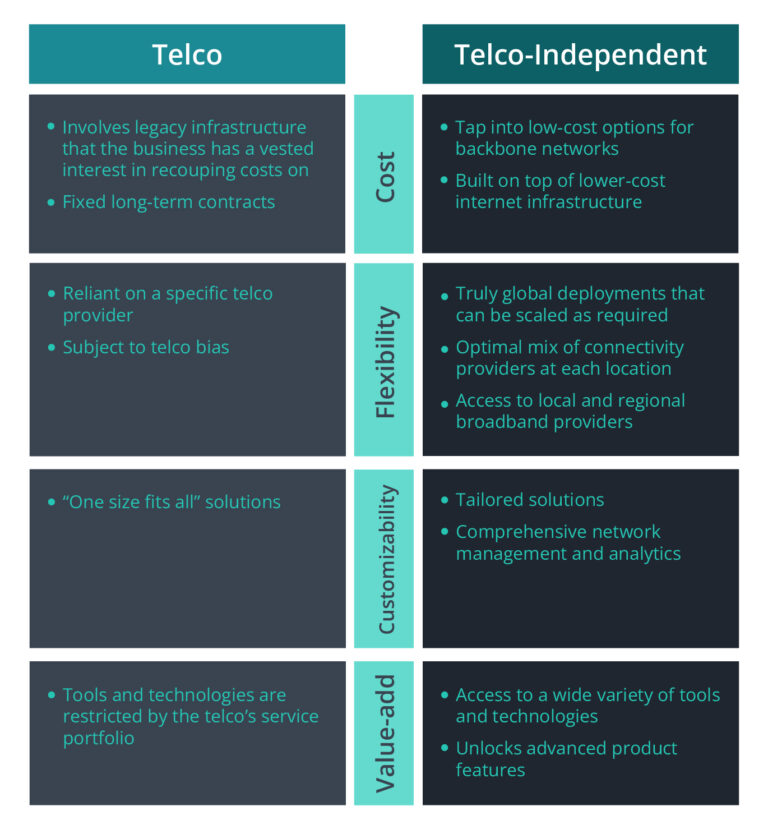The Key Advantages of the Telco-Independent Approach
4 ways your enterprise can benefit
Over the past three years, the world has experienced a rapid acceleration in digital transformation. Enterprises are now heavily reliant on modern technology, which means modern enterprises must develop or acquire network infrastructure that can meet the fast-evolving demands of customers and industries.
The need for the right network infrastructure
With the widespread adoption of hybrid and remote work, enterprises need reliable, stable, and secure networks that enable employees to work effectively from anywhere, anytime. Increased digital transformation has also led to many organizations adopting advanced digital solutions such as industrial Internet of Things, artificial intelligence, and big data analytics.
To properly support advanced digital solutions and cope with fluctuating data and bandwidth requirements, enterprise networks must be able to quickly scale up or down depending on the enterprise and its workforce’s needs at any moment.
This has led to the adoption of Software-Defined Wide Area Networks (SD-WAN) to deliver increased flexibility and better performance at a lower cost.
Why should enterprises consider telco-independent solutions?
While some traditional internet service providers (ISPs) are providing SD-WAN solutions to meet today’s increased network needs, legacy infrastructure, and rigid contracts mean ISPs may not be able to offer the necessary level of agility, functionality, and affordability to keep up with the changing demands of the modern enterprise.
In contrast, telco-independent alternatives — usually accessed through a managed service provider (MSP) — have become more prevalent as they can deliver a host of benefits. These include being able to access the full potential of the technology, greater flexibility on how the enterprise’s environment is managed, optimization at the underlay at every site, as well as increased cost-effectiveness and no carrier lock-in.
Here are four ways your enterprise can benefit from a telco-independent approach.

Reduced costs
Traditional ISPs and telcos tend to offer fixed long-term contracts which may lock their customers in, resulting in higher costs. When proposing network solutions, telcos must also consider the return on investment of their legacy infrastructure and back-to-back agreements with infrastructure partners. This leads to questions surrounding the integrity and costs of the network solution as the enterprise’s needs aren’t at the forefront of the decisions.
With the rise of low-cost options for backbone networks globally, the telco-independent approach enables enterprises to leverage these low-cost options to meet their own unique business and network needs. The telco-independent approach is also often more affordable as such networks can be built on top of lower-cost internet infrastructure.
Greater flexibility
As the term suggests, a telco-independent approach means you are not reliant on any one specific carrier; you can choose the providers that are best suited to your enterprise. This way, enterprises avoid telco and technology bias, enjoy more freedom and flexibility, and can move at the speed of modern business.
With a telco-independent approach — particularly with a partner that operates across multiple markets and geographies — enterprises can enjoy truly global deployments that can be scaled as required. With an optimal mix of connectivity providers at each location, the enterprise can enjoy the best possible performance and services, to deliver better business outcomes.
Furthermore, breaking away from traditional ISPs provides enterprises with access to local and regional broadband providers who, together, provide greater performance due to combined investment across thousands of providers at the local level. Your MSP may also grant you wider geographic accessibility, so you can use the best servers for the fastest response times.
Customizability — how the service is managed
The traditional fixed contracts that traditional ISPs and telcos tend to offer are “one size fits all” solutions limiting the types of software, services, and capabilities accessible to the enterprise. A model like this often leads to the enterprise accessing unwanted features and paying extra for those it wants — resulting in low to no business value. A telco-independent solution removes this limitation and enables tailor-made solutions aligned with business needs. With this customizability, enterprises pay for precisely what they need and are empowered to select the capabilities and services that they require to succeed. A strong partnership with your MSP can also help you tailor your network solution to your specific business use cases, maximizing the value of the technology.
In terms of managing the service, working with a telco-independent MSP can enable comprehensive network management and analytics — your enterprise and IT team will have greater access, visibility, and control of your data and environment, so the enterprise stays nimble and agile. Some MSPs may even offer co-managed solutions where the MSP works alongside your internal team, to ensure support and additional value at every stage of the network lifecycle.
Unlocks desired product features to deliver additional value
The telco-independent approach gives enterprises access to thousands of ISPs and telcos. Using a multi-vendor approach means enterprises get access to a wider variety of tools and technologies than if they were tied to one provider.
By eliminating telco bias and providing the enterprise access to a plethora of tools, a telco-independent approach essentially enables every enterprise to pick — or build — their best possible network solution while unlocking advanced SD-WAN features such as dynamic multi-path optimization that provides a foundation to address challenges associated with cloud migration, multi-cloud workloads and adopting to a hybrid workforce.
Optimize your business performance with telco-independent SD-WAN solutions
To be future-ready and achieve positive business outcomes, enterprises today want flexibility, agility, and the ability to tailor-fit solutions to meet their exact business needs. At the same time, rising inflation and macroeconomic headwinds are prompting enterprises across industries, sectors, and geographies to tighten belts and reduce costs.
Given this business context, modern enterprises need to build agile, sustainable networks that support global connectivity and hybrid workforces, deliver cost savings, and are customized to network requirements — and the telco-independent approach ticks all the boxes.
Visit coevolve.com/services/telco-independent-sd-wan-solutions to learn how Coevolve’s managed, Telco-Independent SD-WAN Solutions can help you meet your enterprise network needs.